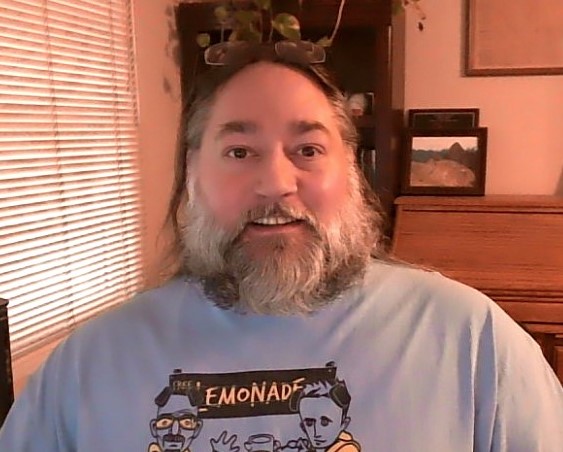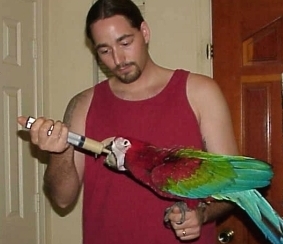 |
Associate Professor Computational Biochemistry & Biophysics Email: eric.sorin@csulb.edu Phone: 562.985.7537 Office: MLSC-322 |
 |
Brief Biosketch
Stanford University (2007)
Ph.D. Chemistry/Chemical Physics
Research: Biomolecular simulation, protein & RNA folding, distributed computing applied to molecular biology & biophysics
UC Riverside (2000)
B.S. Chemistry/Chemical Physics Research: FT-IR & Raman spectroscopy and microscopy studies of organic compounds
Victor Valley College (1998)
A.S. Science & Mathematics
A.A. Liberal Arts
Teaching Assistant for Introductory, General, and Organic Chemistry; Level II Tutor in the sciences,
as well as Mathematics, Philosophy, Psychology, and English.
Previous Employment
The Prestige Company
Ornamental glass blower (apprentice) and training assistant
Useless Trivia
Animal Husbandry
Before and during my graduate studies, we kept and bred AKC Boxers (our babies "Entropy" & "Harmony") and a variety
of "exotic" animals including lizards (chameleons, beardies, frillies, uromastyx), snakes (corns, rainbow and red-tailed boas),
and birds (macaws and a feisty cockatoo named Einstein). My family then discovered the wonderful world of owning cats, and I am now the property of two felines.
Welcome to my CSULB Homepage!
I have been with the Department of Chemistry & Biochemistry since fall 2007 and have continually been challenged and amazed by our students, both in the classroom and in the lab! Whatever the reason for your visit, you should find the links at the top of this page useful, but please email me if you don't find what you're looking for.
Teaching: My primary teaching duty early on was the CHEM 377A/B Fundamentals of Physical Chemistry sequence for Biochemistry and other non-chemistry majors. I also developed and teach CHEM 480/580 Biomolecular Modeling & Simulation, a graduate level course focusing on the computational methods of studying biomolecular systems, and our CHEM 361 Chemical Communications course. In the spring of 2016, I developed and taught our first offering of the single-semester CHEM 375 Physcial Chemistry for Engineers course, which was a fantastic experience, and in the fall of 2017 I developed and taught our first offering of NSCI 496 Advanced Biomedical Research Methods, a component of our new BUILD-funded research-infused curriculum aimed at preparing senior level STEM majors for graduate-level research and studies. I spent 2017 and 2018 teaching second semester General Chemistry (CHEM 111B), which was a fantastic experience -- our lower division students have so much spirit and enthusiasm! I've since been teaching a combination of these courses, as needed, with Physical Chemistry Laboratory (CHEM 373) thrown in now and again.
Research: You can learn more about our computational studies of biochemical and biophysical systems and processes via the links above. Using worldwide Folding@Home distributed computing resources, we focus on 3 primary areas: (a) protein & RNA folding, (b) enzyme inhibition and enzyme-drug interactions, and (c) the effects of point mutations on the collagen triple helix. As a research advisor for undergraduates and Master's candidates, my primary goal is to offer my students a "full spectrum" research experience, from the initiation of new projects, to the collection and analysis of data, to the publication and presentation of their results. Such opportunities expose my students to real-world computational research in a highly interdisciplinary field, provide them with experience working alongside and collaborating with peers from a number of other majors (biology & biochemistry, chemistry & chemical engineering, physics, mathematics, and computer science), and offer them to chance to determine if they are suited for, and eager to pursue, advanced research/graduate school in the sciences.
Service: Early in, I led the effort to completely revamp our Department's website, which we've revamped again in recent years. I've also aided in our summer orientation program for incoming Chemistry & Biochemistry majors, served on the CSULB Academic Senate and Faculty Advisory Committee on Technology, and served on the Research and Curriculum Committees at both the Department & College levels. I was particularly excited to be a part of our now-defunct Partners for Success program, in which I mentored/monitored at-risk/probationary CSULB sophomores and, most recently, I served on the search committee for our new CNSM Dean. With my colleagues, and Prof. Emeritus Doug McAbee in particular, I led the initiation of a new B.A. program in Biochemistry to better serve our pre-professional majors.
